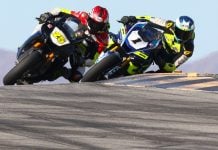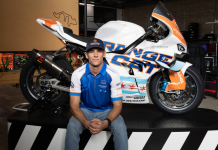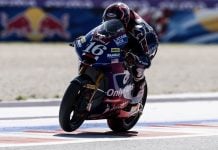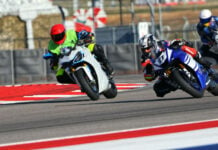Pirelli in the “temple of speed” with specifically designed 17 inch Diablo Superbike solutions In order to take on the fastest and most demanding track on tyres (along with the Phillip Island track), Pirelli will be bringing a few development solutions based on the standard ones but which adopt particular measures that have been specifically researched for the Brianza circuit. The new intermediate tyre available to the Superbike riders may prove to be essential in the event of varying weather conditions like last year Monza (Italy) – The brand with the long P is ready to race on its home track with the new 17 inch Diablo Superbike tyres for the top class and with the Diablo Supercorsa SC tyres for the Supersport, Superstock 1000 and Superstock 600 classes. In particular, for the Superbike class, given the peculiarities of the Brianza track and the power that modern engines achieve, Pirelli is bringing standard tyre solutions for the rear that adopt particular measures such as reinforcement of the blend in the central section capable of preventing problems such as blistering, typical of very fast tracks like Monza that put tyres to a hard test. If weather conditions are particularly unstable like last year, the riders will have another weapon in their arsenal this year, the new intermediate tyre designed by Pirelli, the Diablo Wet. Diablo Wet was designed and made precisely for the purpose of being used in cases where the race starts on a wet track which then dries out and vice versa or, as is typical at the Monza track, when parts of the track are completely wet due to precipitation while others are almost dry because of the tree coverage. Also, with the introduction of the “Flag to Flag” rule this year, even in particularly adverse weather conditions the race will not be suspended, but the riders will be able to make a pit stop to change tyres. However, this will cause them to lose a lot of time to make the change. For precisely this reason, if these are the racing conditions, the new intermediate may prove to be priceless for race strategy and to avoid any pit stop which would otherwise be inevitable. The “Autodromo Nazionale di Monza” is 5793 metres long and has 5 left-hand turns and 8 right-handers. There are four long straight stretches where the bikes can even exceed 330 kph. This is why enthusiasts know it as the “temple of speed”. It is one of the oldest permanent race tracks in the world, along with Spa-Francorchamps, Indianapolis, Montlhéry and Brooklands. In fact, the Automobile Club of Milan decided to begin construction on it in January of 1922 in commemoration of the foundation’s twenty fifth anniversary. Monza from a tyre point of view: The length of the straight stretches, the sustained high speeds and violence of the braking zones place stress on the central part of the tyre with demands that no other track in the championship has. The Monza circuit, practically the only one of its kind in the world, is extremely demanding on the centre of the tyre section because of the long straight stretches and abrupt braking sections. Basically, the thermal energy developed at a zero lean angle both in acceleration and in braking is about 5 times greater than that developed at Assen. Then there is the thermal demand on the right-hand shoulder which, especially in the Biassono turn, stays in a lean for a long time in acceleration, reaching thermal energy values on the shoulder that begin to approach the record levels of Phillip Island. The maximum peak on the right-hand shoulder touches 160° in the Biassono turn and coming out of the Parabolica. The tyre temperature hovers above 100° for 6 seconds in the Biassono and for 8 seconds in the Parabolica. As the bikes approach the Ascari section, which has two left-handers with chicanes, the left shoulder of the tyre is at very low temperature conditions. On the starting stretch the bike’s throttle stays wide open for 1.2 Km which last 18 seconds, soaring above 300 kph for about 350 metres which correspond to more than 4 seconds. At 250 metres from the first curve the riders lean hard on the brakes to manoeuvre through the right/left chicane, speed dropping an astonishing 250 kph and the brakes stay on for 300 metres that last 7 seconds, with thermal stress on the tyre 5 times greater than on any other circuit. Then, after the first section we find the Biassono turn, a long right-hander with a wide radius of about 300 metres where the tyre stays at a 50° lean angle for 400 metres which last 7 seconds at a speed of 230 kph, thermally stressing the right shoulder which reaches more than 100° for 6 seconds, touching peaks of 160°, significant energy which is exceeded only in the last turn at Phillip Island. After the second Lesmo turn, the temperature on the right shoulder is 70° higher than the left. On the Curva del Serraglio, the Pirelli tyre’s special structure quickly makes up this difference, coming into the Ascari turn with a difference of just 15°. Here, without ever dropping below 100 Km/h, the tyre reaches angles of about 55° on the left-hand side, then moving to 55° on the other side with a drop into the lean angle at rates of up to 100° per second. The balance of the two sides helps exit from the last turn, to rocket towards the Parabolica braking zone where the tyre’s right shoulder temperature will stay above 100° for 8 seconds. Monza from a technical point of view: “For Pirelli the Monza round is always considered as a home round because our main headquarters are just a few kilometres from the race track” said Pirelli Moto Racing Director Giorgio Barbier “By now it is well known that this track, together with the Australian circuit, is by far the most demanding where tyres are concerned because of the sustained high speeds and the violence of the braking sections. These are characteristics that stress the central part of the tyre section in a way that none of the other tracks in the World Superbike Championship do. Basically, the thermal energy developed at a zero lean angle both in acceleration and in braking is about 5 times greater than that developed at Assen. Furthermore, the thermal demand on the right-hand shoulder where, especially in the Biassono turn, the tyre stays in a lean for a long time in acceleration, reaching thermal energy values on the shoulder that approach the record levels of Phillip Island. These issues are further complicated by problems in terms of the unpredictable weather conditions which gave us a taste last year of the problems that they can create, although this year we are confident that we can take on even the worst track conditions thanks to the new intermediate design. In past years, specifically to handle the critical issues I just mentioned, we have always developed 16.5 inch tyres that had characteristics of not only a more resistant blend in the central section, but also with an oversized profile. This year the biggest challenge was to create similar, but improved solutions compared to the predecessors, still staying at the 17 inch sizes.” Pirelli solutions for the Superbike and Supersport classes: The brand with the long P will bring a total of 4895 tyres to Monza in order to meet the needs of the four classes in the eni FIM World Superbike Championship and the European Junior Cup. The lower Superstock 1000 FIM Cup and Superstock600 UEM European Championship categories will have the Diablo Supercorsa tyres available to them, as they have for the entire championship, only in the standard solutions: specifically, in the 600 class the riders race on an SC1 compound on the 120/70 front and SC2 on the 180/60 rear, the 1000 riders use the SC2 compound in both cases, 120/70 on the front here as well, but 200/55 on the rear. For the Superbike and Supersport classes, given the unique nature and peculiarity of the Brianza track, Pirelli has decided to focus particularly on development solutions which use standard compounds. Each Superbike rider will have 37 front tyres and 36 rear to choose from, whereas the Supersport riders will have 25 front and 27 rear tyres. For the top Superbike class Pirelli offers 4 dry solutions for the front and 3 for the rear. These are joined, as always, by the rear qualifier that riders will be able to use in the three Superpole sessions on Saturday and the intermediate solutions (3 available for both the front and the rear) as well as wet solutions (7 for both the front and the rear). On the front there will be an SC1 solution and three SC2 solutions. The standard SC1 and SC2 slicks (respectively the R426 and R982 specifications), which were already used in the first three rounds of the current season, are joined by two development SC2 solutions that Pirelli had as yet only brought to Phillip Island: the R1220 that looks like a more robust and more protected SC2 compared to the standard one and the R753 which is even more robust than the R1220, to the advantage of even greater wear resistance. For the rear three solutions are planned which we consider to be development solutions because, although they retain the standard tyre compounds, they integrate particular measures in order to handle the problems created by the Italian track, just one of which is the reinforced compound at the central portion of the tyre. For the first time in the 2013 season there will be an SC0 blend solution (S515), the softest available, which should be used in high temperatures. This tyre is basically like the standard SC0 which has the same compound, but it has a reinforced central strip which is able to provide protection against blistering which is a rather common possibility at Monza. The SC0 is joined by two SC1 development solutions in medium hardness compound, the S513 which differs from the standard version only with a reinforced central section and the S514 which, in addition to the reinforced central section, was specifically designed with different internal structure and materials in order to keep operating temperatures particularly low. The peculiarity of reinforcing the central tread strip adopted for the rear race solutions will also be used on the qualifying tyre available to the riders for the Saturday Superpole sessions. These tyres have four pink stripes on them instead of the usual yellow stripes in honour of Mother’s Day which is celebrated in many countries on Sunday race day, 12 May. As for Supersport, on the front the riders will be able to choose from the two standard solutions, the SC1 soft compound (P1177) and the SC2 medium (R1031), already used and brought to all the races so far in 2013. On the rear the riders will be able to choose between a new development solution in soft SC0 compound (S510) which should be used if the temperatures are higher and two medium compound SC1 solutions: The standard R303 and the R1134 solution which was only brought to the Phillip Island round. The 2012 Pirelli statistics for Monza: • Total number of tyres Pirelli brought: 5086 • Number of solutions (dry, intermediate, wet and qualifier only for rear) for the Superbike class: 5 front and 7 rear • Number of solutions for the Supersport class (dry, intermediate and wet): 4 front and 5 rear Number of tyres available for each Superbike rider: 34 front and 39 rear • Number of tyres available for each Supersport rider: 24 front and 28 rear • Superbike Best Lap Awards won by Tom Sykes (Kawasaki Racing Team) in 1’44.707 (Race 2, 7th lap) • Supersport Best Lap Awards won by: Sam Lowes (Bogdanka PTR Honda) in 2’00.653 (16th lap) • Temperature in Race 1: not run • Temperature in Race 2: air 20° C, asphalt 25° C • Maximum race speed reached by Pirelli tyres: 329,1 km/h, Chaz Davies (ParkinGO MTC Racing) in Race 2 on the 8th lap.
Pirelli Bringing New “Diablo Wet” Intermediate World Superbike Tire To Monza
Pirelli Bringing New “Diablo Wet” Intermediate World Superbike Tire To Monza
© 2013, Roadracing World Publishing, Inc.






